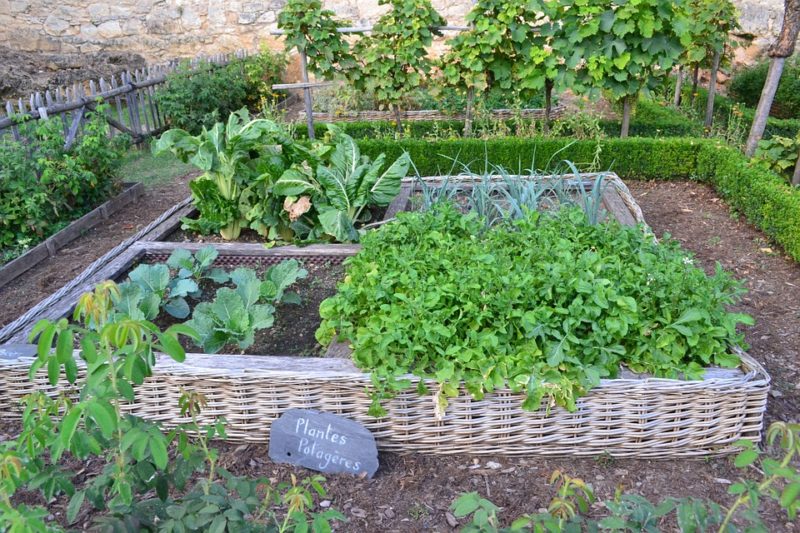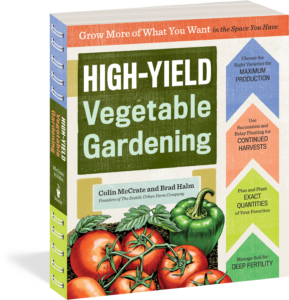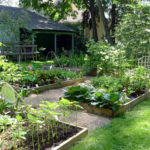When it comes to getting the most from your garden, size does matter, so plan before you plant, with this excerpt from High-Yield Vegetable Gardening.
Annual beds can be created to fit whatever space you have available. As the garden increases in size, you’ll have more opportunities to diversify your crop selection, extend your harvest season, and increase the overall volume of food grown on site. Even the most intensively managed garden space has limits to how much food it can produce, so adding square footage will always add productivity. At the same time, adding space means that you’ll need to invest additional time and materials to create and manage your garden. Even the most intensively managed garden space has limits to how much food it can produce, so adding square footage will always add productivity. At the same time, adding space means that you’ll need to invest additional time and materials to create and manage your garden.
Following are some general guidelines on the needs and potential productivity of different garden sizes. These are only rough estimates: everyone uses a garden differently. Not everyone grows food for the same number of people, and those people will vary in age and dietary preferences. The time needed to manage your space also depends on how tidy and weed-free you like to keep it.
Spend some time considering the number of other time commitments you typically have throughout the year. An honest assessment will really help you determine which garden size may work best for you. The good news is that it’s relatively easy to expand or shrink a garden from year to year; you can adjust as needed after a season or two of experience.

How Big Should My Garden Be?
100–200 Square Feet
This is an appropriate size for a beginning gardener who wants to try a few different crops and eat consistently from the yard during the peak harvest seasons. Half an hour to an hour a week will be enough to keep up with all garden tasks.
200–400 Square Feet
This is a good size garden for the intermediate gardener with a hectic schedule. It will yield adequate fresh produce for one to four people throughout spring, summer, and fall, with some produce left for putting up. An hour or two of work a week will be sufficient.
400–800 Square Feet
A group of two to six people can expect to eat fresh from the garden during the main growing season and also harvest quite a bit for late fall and winter storage. A space this size will require at least two to three dedicated hours per week for upkeep, harvesting, and processing of crops.
800–1,500 Square Feet
This size garden can feed four to eight people through the growing season and produce enough storage vegetables to supplement your diet through much of the winter. Plan to spend at least four to six hours a week managing the space for maximum production and appearance.
1,500–2,000 Square Feet
This is a large-enough garden to feed 6 to 10 people during the season and still distribute small quantities of especially productive crops. With proper planning, it is possible to grow substantial storage crops and cold-season greens. Expect to spend six to eight hours a week keeping up with the garden.
2,000–4,000 Square Feet
This is entering into the realm of a serious undertaking, with a garden that will supply 8 to 15 people with fresh produce through much of the season. Keeping up with this much space will require at least 8 to 12 hours a week. During peak harvest season, you may need to spend several nights a week processing and storing your crops.
4,000–8,000 Square Feet
A very substantial home vegetable garden, this much space will feed up to 20 people and may also provide a few crops for wider distribution. Plan to spend 12 to 15 hours a week, plus extra time for processing and distribution, as needed.
8,000–15,000 Square Feet
The largest home garden we have seen falls in this range. You will have the opportunity to produce great quantities of food year-round for up to 25 people. Plan to spend 15 to 20 hours a week managing your space.
15,000–22,000 Square Feet
Managing this much space will be a part-time job. Expect to spend at least 20 hours per week or more. A garden this size can feed up to 30 people and can provide many opportunities for storage, processing, and selling of produce.
22,000–44,000 Square Feet
This is an endeavor large enough to require a full-time manager. This range is approximately half an acre to one acre (43,560 square feet is one acre). A garden this size is a serious endeavor and will likely require additional equipment and supplies.
TEXT EXCERPTED FROM HIGH-YIELD VEGETABLE GARDENING © 2015 BY COLIN MCCRATE AND BRAD HALM. ALL RIGHTS RESERVED.
 About the Book
About the Book
You won’t believe your eyes when you see the size of your harvest! In High-Yield Vegetable Gardening, authors Colin McCrate and Brad Halm show how you can make your food garden much more productive, no matter how big or small it is. You’ll learn their secrets for preparing the soil, selecting and rotating your crops, and mapping out a specific customized plan to make the most of your space and your growing season. Packed with the charts, tables, schedules, and worksheets you need—as well as record-keeping pages so you can repeat your successes next year—this book is an essential tool for the serious gardener.
Buy the Book
Amazon | B&N | Indiebound | Workman





No Comments